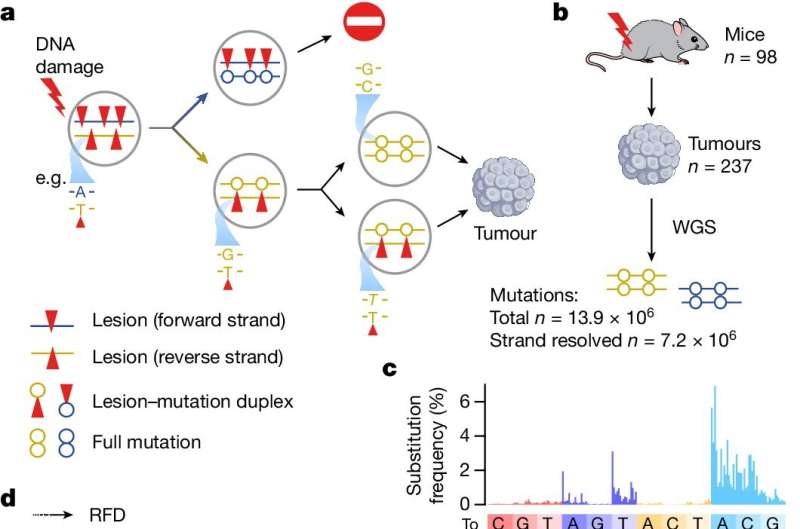This article has been reviewed according to Science X's editorial process and policies. Editors have highlighted the following attributes while ensuring the content's credibility:
fact-checked
peer-reviewed publication
trusted source
proofread
Cancer genome research analyzes molecular evolution of tumors after chemical exposure

Cancer genomes are the result of diverse mutation processes that have often accumulated over decades. Scientists from the German Cancer Research Center (DKFZ) and the Universities of Cambridge and Edinburgh have analyzed the molecular evolution of tumors after exposure to mutagenic chemicals.
DNA lesions that persist unrepaired over several cell generations lead to sequence variations at the site of damage, the quantification of which provides insights into the kinetics and mechanisms of DNA repair. This enabled the researchers to distinguish the contribution of the triggering lesion from that of the subsequent repair in shaping the mutation pattern. These results have now been published in the journal Nature.
After DNA damage, for example by chemicals, the damaged and undamaged DNA strands are separated from each other during cell division. The cells often do not repair the DNA damage immediately; the lesions persist over several rounds of cell division.
The damaged DNA can be copied by specialized enzymes known as translesion polymerases. However, these enzymes incorporate DNA building blocks (nucleotides) at random or simply skip the damaged nucleotide. The daughter cells develop different mutation profiles as a result.
Researchers refer to this as "lesion segregation." This results in complex mutation patterns in a clonal cell population such as a tumor, and can reveal which damaged DNA strand a cancer cell inherited from its "ancestors."
Researchers led by Duncan Odom, DKFZ, Sarah Aitken, University of Cambridge and Martin Taylor, University of Edinburgh, investigated the question of how this asymmetry of DNA damage and DNA repair comes about. In particular, they wanted to clarify whether it plays a role in the mutation rate which of the two DNA strands is damaged.
Despite the symmetry of both strands of the DNA ladder, they differ in many respects: only one of the strands is read into RNA, different machinery copies each of the two strands during replication, and both strands are differently accessible to repair enzymes.
The team used a mouse model to investigate how diethylnitrosamine damages liver cells and ultimately causes liver cancer. The substance damages the genetic material by chemically bonding with a base. Experts refer to such stable attachments as small DNA adducts. For their current study, the researchers examined 237 tumors from 98 mice and analyzed over seven million mutations.
Contrary to expectations, they found no significant differences in the mutation rates of the two strands of DNA (leading and lagging strand) despite their replication being performed by different processes. They went on to show that on encountering damage, both processes recruit the same damage bypass machinery with the same efficiency.
This stands in stark contrast to the asymmetric strand tolerance of the much more space-consuming UV light-induced adducts and gives new insight into how cells deal with the DNA damage caused by smoking and cancer treatments.
The accumulation of several different mutations at the site of persistently unrepaired DNA lesions can be used to measure the efficiency of repair processes—in the entire genome and with a resolution of single nucleotides.
The researchers found that the mutations induced by DNA damage are largely shaped by the influence of DNA accessibility on repair efficiency rather than where damage occurs.
Finally, they reveal specific genomic conditions that actively drive cancer-promoting mutagenesis by impairing the reliability of a specific repair mechanism called "nucleotide excision repair."
Odom, one of the senior authors of the study, summarizes, "Our results shed light on how strand-asymmetric mechanisms of DNA damage generation, tolerance and repair underlie the evolution of the cancer genome."
More information: Craig J. Anderson et al, Strand-resolved mutagenicity of DNA damage and repair, Nature (2024). DOI: 10.1038/s41586-024-07490-1



















